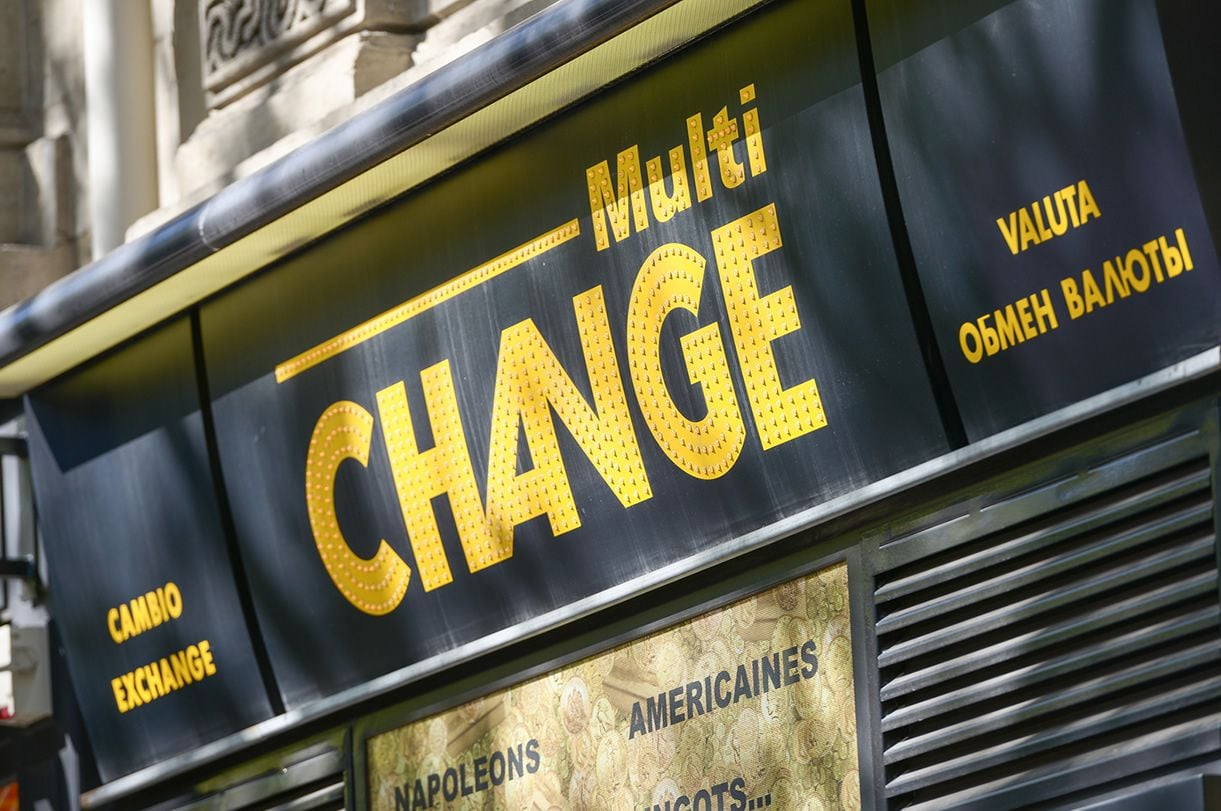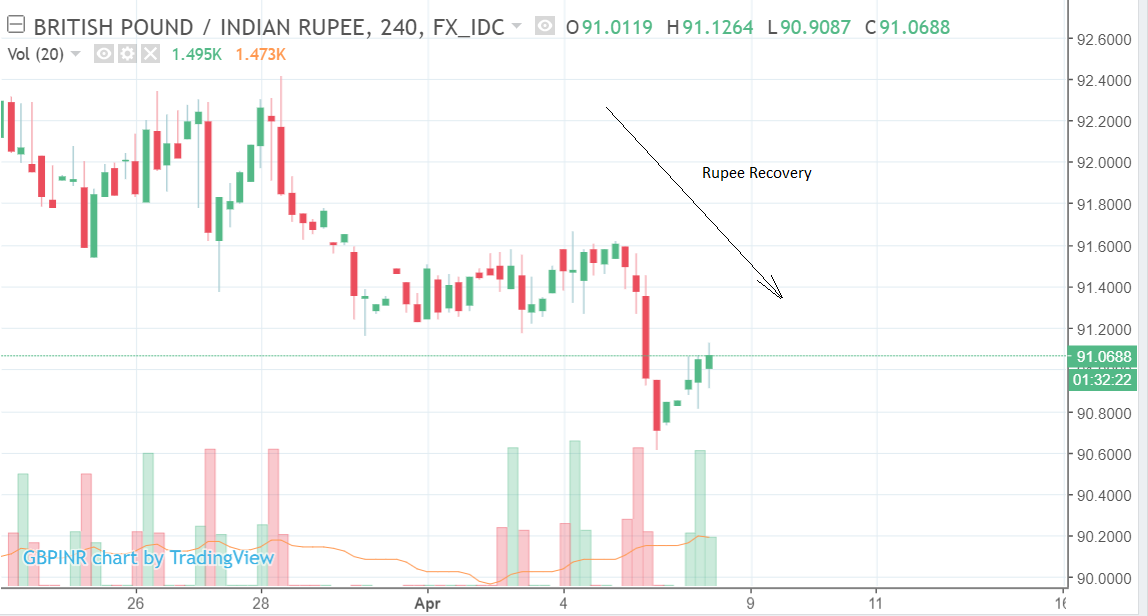Indian Rupee Could be a Surprise Beneficiary of Escalating Trade War as Analysts say Medium-Term Expectations for INR are Positive
- Rupee is currently making a short-term recovery
- Trade wars may provide opportunites though risks high too
- Medium-term outlook for the currency is unanimously positive

© Goodpics, Adobe Stock
The Indian Rupee's medium-term outlook remains positive and fallout from the trade war could be surprisingly beneficial for the currency.
The Rupee (INR) is currently recovering and whilst it is too early to say it is making a full come-back, the relief rally stands in marked contrast to the steady depreciation which has characterised most of 2018.
INR has weakened due to a combination of the rising oil prices (India has to import all its oil) and fears about the banking sector, which is saddled with a high proportion of non-performing loans.
As we can see, the Pound-to-Rupee exchange rate has been falling over recent weeks as the INR hits recovery-mode:
Despite its poor performance during 2018, the overall trajectory of the currency remains positive if we look at the longer-term and analysts generally remain upbeat about the medium-to-longer-term prospects of INR.
"We keep our forecast of a gradual strengthening (of INR)," says Jakob Ekholdt Christensen, chief analyst and head of emerging markets at Danske Bank, who adds, "as a robust global economy is favourable for FX carry. With India offering macro stability, decent growth, and high relative rates it should support a moderately stronger INR."
India's attractive combination of high interest rates of over 6.0% and reform-minded, modernising, highly-diversified, economy offers a seductive sirren-call to a lot of investors.
The carry trade involves borrowing a currency in a jurisdiction where interest rates (and therefore borrowing costs) are exceedingly low, such as the Yen in Japan or the Euro in the Eurozone, and investing that money in a currency where interest rates are much higher such as in Indian Rupee. The difference in what is earned and the cost of borrowing is the profit.
But Danske's Christensen is not the only one of a bullish view, TD Securities' analyst Christian Maggio shares his outlook:
"We remain cautious on the INR over the near due to higher external market volatility, but maintain a positive stance on the currency over the medium term," says the head of global markets strategy in recent note.
An encouraging outlook for growth, bolstered by a recent upwards revision of growth expectations in 2019 by the Reserve Bank of India (RBI) coupled with a lower inflation forecast is the perfect mix for any currency, as it shows growth uneroded by inflation.
Add to this the government's reforms to make it easier for foreign companies to invest in India and buy Indian bonds, and the outlook for inflows and, therefore, Rupee looks increasingly positive.
Trade Tensions and the Rupee
Although the current China-US trade spat has been viewed as overall negative for emerging market growth, more-or-less directly in proportion to the level of escalation, India may prove to be something of an exception.
An escalating trade war will hurt "export-dependent emerging markets, notably in the Asian region," says Danske, such as Taiwan but perhaps not India as much, which is not as reliant on exports.
Indeed, there may even be unexpected opportunities for India to capitalise on any evolving trade war.
The new tariffs proposed by Beijing on US agricultural imports could provide an opening for Indian agricultural exports, further increasing demand for, and the value of, the Rupee.
China has targeted US soybean imports with tariffs of which it imports a massive 60% of all US soybean exports.
There is a great demand for the product in China where it is used to feed farmed animals, including pigs and chickens, as well as fish - animals which are in turn used to help feed China's enormous population.
Beijing singled US soybeans out for tariffs purportedly because they are mostly grown in states which voted for Trump, so punitive tariffs are likely to damage his popularity in amongst his core voters.
India is another major grower of soybeans so a breakdown in trade between China and the US could leave a supply vacuum which it could fill.
"China will need to set about sourcing the extra soybeans it needs from other countries," says a report on the BBC news website.
"India is one of the world's biggest soybean producers, and analysts there have already pointed to a potential trade war between the US and China as an opportunity for its economy," the report goes on to say.
India is not the only source, however, "other big soybean producers are Argentina and Brazil, and some studies suggest that is where China will turn to should the current set of proposed tariffs come into force," adds the report.
Indeed it is far from a done deal. Beijing is not on especially good terms with India after President Modi started his own mini trade-war with the Chinese back in February when he proposed increasing tariffs on Chinese consumer goods and electronics.
"The budget raises duties, typically to 20 percent, on two broad groups of products that India imports mainly from China," says a report by Mary Lovely, a contributor to the Financial Times.
"The first group is an assortment of labour-intensive activities. The government is doubling duties on beauty aids, watches, toys, furniture and footwear," says Lovely, adding:
"The second group of sectors in which tariffs are being doubled comprises electronics and communications devices, including mobile phones, televisions and associated parts and components. Here again the competition is mainly imports from China."
There is also the risk that India may fall out with the US due to its habit of currency manipulation.
"We think this risk is not entirely trivial given India's large trade surplus with the US, and India's frequent meddling with the exchange rate - in fact, India could be classified as 'currency manipulator,' based on the US Treasury's definition," says Maggio.
Yet although there is the possibility India may be branded a manipulator and suffer consequences, Maggio does not see this as a likely outcome.
"India may easily tick two of the three requirements in the US Treasury's semi-annual report on trading partner currencies, due to be released shortly. If this is the case, then India may face a rebuke from the US administration, together with other Asian economies, but fall short of US-imposed retaliatory measures," he concludes.
The current game of trade war between the US and China seems to pose both risks and rewards for India and its Rupee - if it plays its cards right and with a modicum of luck, it could find itself an unlikely beneficiary - but at the same time there are risks it could become a victom of the cross-fire, with negative effects for both the economy and the Rupee.
Get up to 5% more foreign exchange by using a specialist provider to get closer to the real market rate and avoid the gaping spreads charged by your bank when providing currency. Learn more here.

